Thank you for visiting! By the way… any links on this page that lead to products on Amazon and other stores/partners are affiliate links Aquarium Store Depot earns a commission if you make a purchase.
Are you looking for the perfect tank mates to add some color and excitement to your Oscar Fish Tank? If so, welcome! Keeping a healthy balance in an aquarium is key for successful fish keeping – both for the well-being of your tank inhabitants as well as creating an aesthetically pleasing setup. Understanding which species are ideal companions with Oscars can help ensure that you have a beautiful tank that is suitable for its inhabitants. This blog post will provide you with our top 10 recommendations on Oscar Tank Mates and how they can create a vibrant ecosystem in your home aquarium.
Key Takeaways
- Oscar fish are one of the most exciting freshwater fish to keep in the aquarium hobby.
- Oscars are large fish that aren’t usually kept with other fish due to their size and behavior.
- A few fish species make great oscar tank mates as long as the tank size and filtration can accommodate them.
- Oscar fish should never be kept in community tanks and should be considered a type of monster fish instead.
Introduction To Oscar Fish
Before we jump into the best tank mates for Oscars, we need to understand how oscar fish behave by themselves and with others. These are one of the most dynamic and charismatic fish in the freshwater aquarium hobby and are often referred to as water puppies.
The oscar fish is a large species of South American cichlid scientifically known as Astronotus ocellatus1. These fish are regularly sold as juveniles when they are only just a couple of inches big. Their bright colors and ‘easy’ care requirements make them popular among unknowing beginner hobbyists. The truth is that oscar fish can grow to be over 18 inches long and live to be 20 years old.
Oscar fish are not beginner fish and should only be kept in large tank setups. That means that adding tank mates would require an even bigger setup.
Tank Requirements
Alone, an oscar fish requires a 75-gallon tank setup. A 125-gallon aquarium is preferred to give your fish more room to swim and to keep water parameters balanced. Oscar fish are messy eaters and can create a lot of waste, so a large and efficient filtration system is definitely required.
Otherwise, oscar fish have simple tank requirements. They need some structure for protection in the form of rocks or driftwood. A sandy substrate is preferred to allow your fish to burrow and arrange its home as it sees fit. Regular tank maintenance is a must to keep waste levels down.
As you can see, oscar fish are big, messy fish. Add more oscars or other fish species into the mix and you’re looking at a relatively demanding system. Many hobbyists are successful at keeping other fish with oscars despite their needs, though.
Do They Need Tank Mates?
The question at hand is, do oscar fish even need other tank mates at all?
The answer is no.
Oscar fish don’t get lonely and can happily entertain themselves. As mentioned before, these fish are the puppies of the freshwater aquarium hobby and can be personally interacted with in ways that can’t be done with other species.
There are a few ways that oscar fish can be given enrichment:
1) Create a dynamic aquarium setup. One of the best ways to keep your oscar fish engaged is by giving it an intricate home. Use rocks and driftwood to create burrows and tunnels. Regularly shift items around to keep your fish guessing what comes next without kicking up the substrate too much. This gives your fish different ways to recreate and rearrange its new home.
2) Introduce new items. On top of moving objects around, add new pieces and remove old ones. Some hobbyists even add cheap live plants that can be uprooted and eaten for an additional treat. Other alternatives include plastic floating balls and air stones.
3) Feed live food. Another great way to enrich your oscar fish is by giving live food every now and then. These freshwater fish have a big appetite and will eat even when they’re not hungry, though we don’t recommend overfeeding them! Oscar fish will happily take worms, brine shrimp, and even live fish and snails; use caution when introducing live fish and snails, as they can carry parasites.
4) Make feeding time exciting in addition to feeding live food and make dry foods exciting to eat. Oscar fish are known for waiting at the surface of the water for food and responding to objects (including fingers) entering the tank. Some Oscars can be trained to do simple tricks before they are fed. Food can also be placed in feeding mechanisms that make the fish work for its meal.
5) Add tank mates. Lastly, oscar tank mates may be added to the aquarium, including other Oscars. This provides constant interaction and reaction between the fish.
Top 10
If you have the space and filtration to consider possible tank mates for oscar fish, then you will need to decide which species best fit your system. Oscar fish aren’t particularly aggressive fish, but they need to be paired with large species that can tolerate being investigated and nudged from time to time.
Here are some of the best oscar tank mates available for a large freshwater fish tank setup!
1. Other Types

- Scientific name: Astronotus ocellatus
- Temperament: Semi-aggressive
- Origin: South America
- Size: 18 inches
- Minimum Tank Size: 75 gallons
- Diet: Omnivore
- pH: 6.0-8.0
- Temperature: 75-82°F
- Difficulty to breed: Difficult
Oscar fish might not seem like schooling fish, but they can sometimes be found in small groups throughout their natural habitat in the Amazon River basin. These fish can be kept in a loose school setting, given the right aquarium conditions.
By themselves, oscar fish do not appear to be schooling fish at all. They happily explore the tank by themselves and feel comfortable out in the front of the aquarium alone. But given the space and the numbers, oscar fish will move together in a loose school.
This is best achieved in a large tank with similar-sized fish introduced together.
What Size Tank Do You Need For 2?
It is not recommended to keep only 2 Oscars together. It is very difficult to tell males apart from females, which could lead to a combination of two males. While not overly aggressive fish, two male oscar fish will definitely fight.
Unless the two fish are a known breeding pair, oscar fish should only be kept by themselves or in a group.
How Many Can Live Together?
Given unlimited space, there is no limit to how many oscar fish can live together. Eventually, even a large group would dissipate into smaller groupings.
For a captive-kept group, 7 oscar fish is ideal. This will require at least a 300-gallon tank.
There is a big difference in temperament between a solitary oscar and a shoal of Oscar. Oscars that live alone are very playful and responsive to their owner’s actions. A group of Oscars is much mellower and uniform in their intentions.
2. Blood Parrots
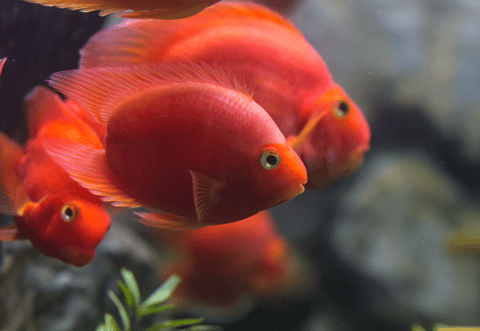
- Scientific name: Hybrid
- Temperament: Semi-aggresssive
- Origin: Not naturally occurring
- Size: 8 inches
- Minimum Tank Size: 55 gallons
- Diet: Omnivore
- pH: 6.5-8.0
- Temperature: 72-80° F
- Difficulty to breed: Mostly infertile
Not the most popular oscar pairing; the blood parrot is extremely popular on its own. This is a hybrid species created by selectively breeding different types of cichlid, mainly species from Central America. Blood parrots are largely infertile as a result.
The problem with blood parrots as tank mates for oscar fish is the difference in demeanor. Blood parrots are physically inflated and have limited movement and speed. Oscar fish have strong tail fins that can easily overcome a blood parrot.
Still, some hobbyists have made this pairing work as long as neither of them is an overly aggressive fish.
3. Silver Dollars
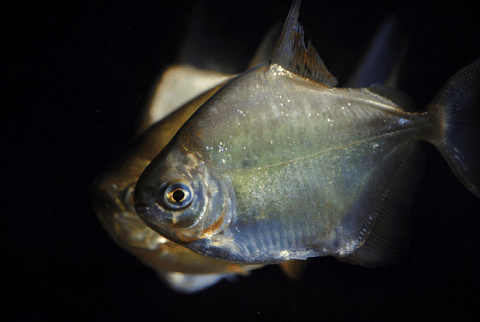
- Scientific name: Metynnis spp.
- Temperament: Peaceful
- Origin: Southeast South America
- Size: 6 inches
- Minimum Tank Size: 30 gallons
- Diet: Herbivore
- pH: 5.0-7.0
- Temperature: 72-77°F
- Difficulty to breed: Easy
If you’re looking for tank mates that will form true schools, then silver dollars are a good choice for an oscar tank. Beware that these peaceful fish get much bigger than you might expect, with individuals growing to be 6 inches each. This means that a school of six can quickly max out a big tank.
It’s also important to note that silver dollars are active fish. They might have a small minimum tank size on their own, but they excel when given plenty of horizontal space to swim.
Silver dollars are one of the best fish species for Oscars due to their size and agility. They are also exclusively herbivores, which can make feeding them and your Oscars separately that much easier.
4. Green Terror
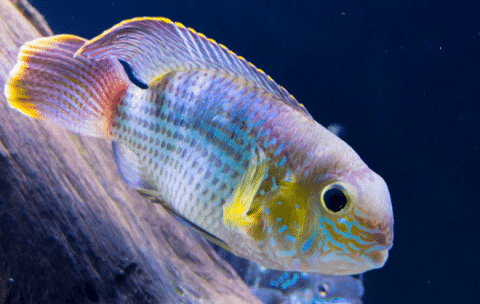
- Scientific name: Andinoacara rivulatus
- Temperament: Semi-aggressive
- Origin: Southeast South America
- Size: 8 inches
- Minimum Tank Size: 55 gallons
- Diet: Omnivore
- pH: 6.5-8.0
- Temperature: 75-80°F
- Difficulty to breed: Moderate
The green terror cichlid is similar in shape, size, and needs to the oscar fish. These two fish have similar demeanors, which helps prevent bullying; juvenile green terror cichlids are more likely to get picked on by older Oscars, so it’s recommended to get them both while they’re the same size.
In most cases, a green terror cichlid and oscar is the best combination available without having a monster fish tank. A 125-gallon tank will fit both of these fish very comfortably. However, temperaments between individual fish can vary, so it’s important to have a backup plan if one needs to be removed.
5. Jack Dempsey Fish

- Scientific name: Rocio octofasciatum
- Temperament: Aggressive
- Origin: Central America
- Size: 10 inches
- Minimum Tank Size: 55 gallons
- Diet: Carnivore
- pH: 6.5-8.0
- Temperature: 75-82°F
- Difficulty to breed: Moderate
The Jack Dempsey cichlid is one of the most popular and well-known species of freshwater fish available. These are big, colorful fish that have fierce personalities. There are several varieties of Jack Dempsey available for even more heightened coloration.
Jack Dempsey cichlids are a good tank mate option for most oscar setups. These are aggressive fish that grow to be around the same size as Oscars and can hold their own in a fight. Still, fighting is not ideal and can lead to injury and eventual death.
The best way to increase compatibility between a Jack Dempsey cichlid and an oscar is by picking individuals that are similar in size and introducing them into the aquarium at the same time. This leaves equal opportunity for territories to be claimed.
Also, do not buy a breeding pair of Jack Dempsey as they will become incredibly aggressive toward all other fish in the aquarium.
6. Giant Gourami

- Scientific name: Osphronemus goramy
- Temperament: Generally peaceful
- Origin: Southeast Asia
- Size: 18+ inches
- Minimum Tank Size: 200 gallons
- Diet: Herbivore
- pH: 6.0-8.0
- Temperature: 68 – 86°F
- Difficulty to breed: Difficult
The giant gourami isn’t commonly seen in the aquarium hobby anymore, but–if you’re able to get your hands on one–could be a great choice for a large oscar tank. Simply put, giant gouramis are giant and can easily surpass 2 feet in length. Surprisingly, they’re relatively peaceful fish that intimidate Oscars out of sheer size; mature giant gourami has been known to become more aggressive as they age.
In some ways, the giant gourami is the best tank mate species for Oscars as their calm demeanor also calms down the Oscars. Giant gouramis have also been known to relax overly dominant male Oscars.
7. Arowanas
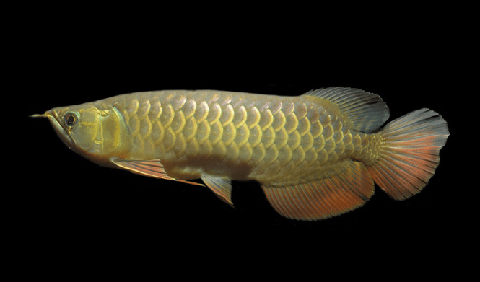
- Scientific name: Osteoglossinae subfamily
- Temperament: Semi-aggressive
- Origin: South America
- Size: 2.5 feet
- Minimum Tank Size: 250 gallons
- Diet: Carnivore
- pH: 6.0-7.0
- Temperature: 75-82°F
- Difficulty to breed: Difficult
Arowanas, most commonly the silver Arowana (Osteoglossum bicirrhosum), are regularly kept in oscar tank setups–if you have the space for a potentially 3-foot fish. Arowanas are one of the most unique fish species available in the aquarium hobby.
Arowanas have downward-pointing mouths that create a trapdoor for prey on the surface. This behavior keeps them at the surface of the aquarium, which means they’re less likely to interact with the Oscars below.
Arowanas aren’t always big, though; smaller ones can make the perfect snack for a larger oscar. When buying an Arowana, make sure that it can’t easily fit into the mouth of your oscar.
What Bottom Feeders Can Live With Oscars?
It’s always ideal for picking tank mates that don’t cohabitate at the same levels of the tank. That’s one of the reasons why the surface-dwelling Arowana is a great choice for an oscar tank setup. Luckily, there are a few potential oscar tank mates to fill up the bottom of the tank too.
8. Clown Loaches
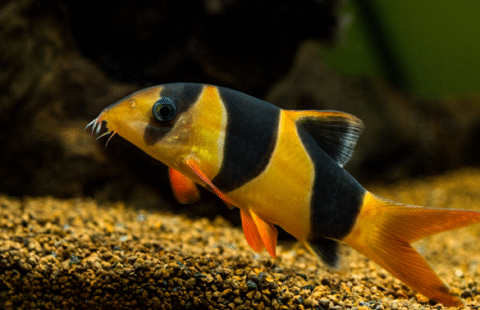
- Scientific name: Chromobotia macracantha
- Temperament: Semi-agressive
- Origin: Southeast Indonesia
- Size: 12 inches
- Minimum Tank Size: 75 gallons
- Diet: Omnivore
- pH: 6.0-7.5
- Temperature: 72-82°F
- Difficulty to breed: Rarely documented
Clown loaches might not seem like they could be oscar tank mates, but that’s because many hobbyists fail to realize their potential mature size. The clown loach can grow to be over a foot in length. Add on the fact that these loaches need to be kept in schools of at least 6 or more, and you have a pretty demanding fish.
On top of its size, the clown loach is a semi-aggressive fish that will defend its place at the bottom of the tank. They are also a good tank mate choice for Oscars as they will sift through the substrate and help pick up any food that is missed from the messy eaters above.
9. Common Pleco
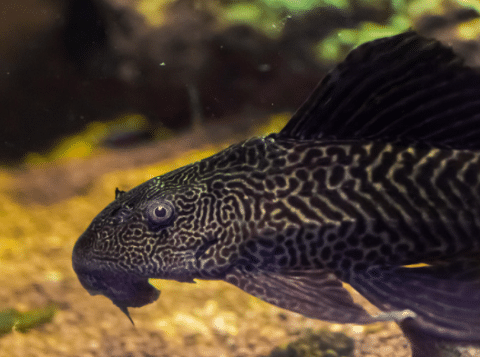
- Scientific name: Hypostomus plecostomus
- Temperament: Generally peaceful
- Origin: South America
- Size: 20 inches
- Minimum Tank Size: 125 gallons
- Diet: Omnivore
- pH: 6.5-7.5
- Temperature: 72-82°F
- Difficulty to breed: Difficult
The common pleco might be seen as a small bottom-dwelling fish to the unknowing hobbyist, but these fish are monsters. The common pleco can grow to be at least 20 inches at full size and live for a long time.
Common plecos are commonly seen in nano community tanks but do best in monster-fish setups or ponds. Though a suckerfish is capable of clinging to vertical surfaces, they tend to stay on the bottom of the substrate, which means that they’ll stay out of the way of their oscar tank mate. In addition, they’ll help clean up any uneaten food.
Common plecos are typically peaceful. However, they’ve been known to cling onto the sides of other fish and become aggressive to species that venture too far to the bottom.
10. Freshwater Stingrays

- Scientific name: Potamotrygonidae family
- Temperament: Semi-aggressive
- Origin: Mainly South America
- Size: Varies
- Minimum Tank Size: 180 gallons
- Diet: Carnivore
- pH: 6.5-7.5
- Temperature: 75-82°F
- Difficulty to breed: Moderate
Freshwater stingrays might not be the first tank mates you think to add to your oscar tank, but they’re one of the best if you have the space and legal permits. Freshwater stingrays are generally easy to care for but require a lot of space and a high-quality protein diet.
Picking the right species is also important to consider in regard to tank size. Here are some of the most popular freshwater stingrays available in the hobby:
- Ocellate river stingray/Moto stingray (Potamotrygon Motoro)
- Bigtooth river stingray/P12 (Potamotrygon henlei)
- Black diamond stingray (Potamotrygon leopoldi)
Though carnivores, stingrays will likely avoid going after live fish; they prefer their natural diet of mollusks and crustaceans. That means that, for the most part, your Oscars and stingrays will live independent lives in the same tank even though they originate from similar areas of the world.
Final Thoughts
Oscars are great fish with tons of personality that can be kept on their own, in a school, or with other tank mates. There is a large selection of oscar tank mates available to the casual hobbyist or the committed enthusiast, with the usual determining factor being space and diet.
These are monster fish that need monster tanks! But as long as their basic needs are met, then both oscar and their oscar tank mates will live together successfully.
- About the Author
- Latest Posts
I’m thrilled that you found Aquarium Store Depot! Here you’ll find information on fish, aquariums, and all things aquatics related. I’m a hobbyist (being doing this since I was 11) and here to help other hobbyists thrive with their aquariums! I adhere to a high quality Editorial Process and Review products with real life field usage and practical analysis.





